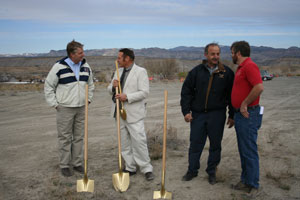CEU Prehistoric Museum breaks ground
The new Mesozoic Gardens were launched on March 23 with almost a hundred people cheering on Marc Bingham, Reece Barrick and Pres. Ryan Thomas for their input into this historic idea to keep the College of Eastern Utah Prehistoric Museum on the cutting edge of paleontology and anthropology.
The first shovelful of dirt was thrown in commemoration of the museum securing the property to build and develop the world’s most extensive and unique evolutionary botanical gardens, as well as the planned expansion site of the CEU Prehistoric Museum.

The new Mesozoic Gardens were launched on March 23 with almost a hundred people cheering on Marc Bingham, Reece Barrick and Pres. Ryan Thomas for their input into this historic idea to keep the College of Eastern Utah Prehistoric Museum on the cutting edge of paleontology and anthropology.
The first shovelful of dirt was thrown in commemoration of the museum securing the property to build and develop the world’s most extensive and unique evolutionary botanical gardens, as well as the planned expansion site of the CEU Prehistoric Museum.
Both Barrick and Thomas thanked Bingham for the generous donation of almost 20 acres of land located on Fairgrounds Road to the College of Eastern Utah. A miniature triangular replication of the glass gardens was displayed at the ceremony.
Barrick explained, that the success of the CEU Prehistoric Museum since its inception in 1961 has resulted in spectacular growth – so much that it has outgrown its current site in downtown Price. The Bingham family donation not only provides the space for the creation of a complete tourist destination, but also provides high visibility from US Highway 6, the main thoroughfare from Salt Lake City to I-70.
The first stage of development planned for this site is the Mesozoic Gardens, a half-acre botanical conservatory complete with living plants that have a direct link to the age of dinosaurs. The conservatory of living fossil plants will be housed within a stunning glass pyramid design including associated research laboratories.
“Imagine the gardens experience,” Barrick added. “Immerse yourself in another time and place … dive into a study of the evolutionary history of plants whose ancestors filled the coal forests and are today helping to power our world.”
CEU and its prehistoric museum hope to use the new facilities as an educational tool to attract students looking for hands-on botanical, paleobotanical, paleontological and ecological experiences. Containing over 600-living plant and animal species having a direct lineage to the fossil record of Western North America, the gardens will provide Western North America, the Gardens will provide a location for international research in fields ranging from conservation genetics to paleoclimatic research.
Bingham’s remarks reflected upon his experiences while living in Carbon County. A Utah State University graduate, he was being transferred from Wyoming to Utah in the ’70s. He was working fulltime for the government making $9,000 a year.
He joined Price Jaycees and learned about setting goals when he came upon the idea to combine Carbon and Emery telephone books. In the basement of his home he produced his first published telephone book. He was immediately sued by Mountain Bell for using their white pages.
Thirty years later, his books are located in almost every state in the nation and in some foreign countries. He originally bought the property on Fairgrounds Road to build his business but eventually relocated to Orem where he could find more employees. He quipped that there were a lot of people who knew how to coal mine in Carbon County but few who could help him publish telephone books.
His Phone Directories Company of Orem, Utah, earned multiple awards and ranks among Utah’s top 50 businesses.
Construction of the new facilities begins with the Mesozoic Gardens, a half-acre botanical conservatory complete with living plants having a direct link to the Age of Dinosaurs.
The “prehistoric dream” is soon to become a modern reality: projected opening for the Mesozoic Gardens is slated for spring 2009, with the completion of museum expansion expected in 2012.




